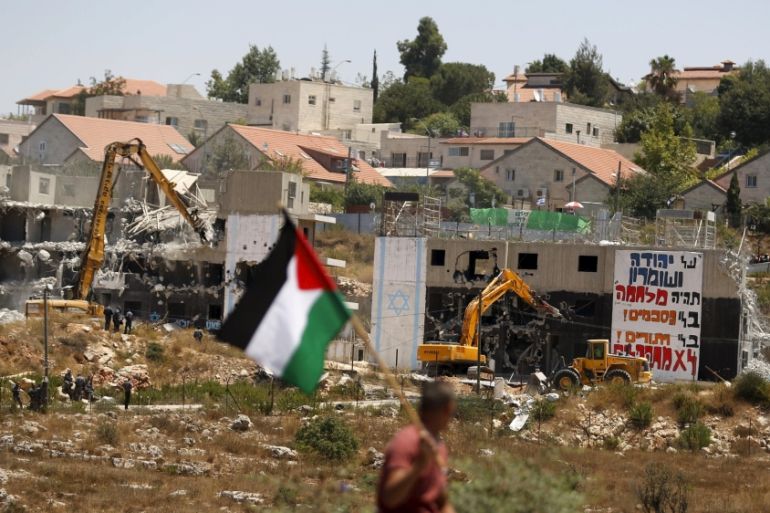Report reveals scale of Israel’s home demolitions
More than 14,000 demolition orders have been issued against Palestinian-owned structures in Area C since 1988, UN says.

Israeli authorities have issued more than 14,000 demolition orders against Palestinian-owned structures, including homes, in Area C of the occupied West Bank between 1988 and 2014, according to a new report by the United Nations Office for the Coordination of Humanitarian Affairs.
Area C is a designation from the Oslo Accords’ era that indicates the region is under full Israeli military and administrative control. The area, home to around 300,000 Palestinians, covers 60 percent of the West Bank and is also where most Jewish settlements are built.
Keep reading
list of 4 items‘Mama we’re dying’: Only able to hear her kids in Gaza in their final days
Europe pledges to boost aid to Sudan on unwelcome war anniversary
Birth, death, escape: Three women’s struggle through Sudan’s war
The report, titled Under Threat: Demolition Orders in Area C of the West Bank, relies on official data obtained via Freedom of Information legislation from the Israeli Civil Administration, the defence ministry unit responsible for the occupied West Bank.
The idea behind this is to prevent these lands from being transferred to the Palestinians under a final status agreement.
More than 11,000 of these demolition orders – affecting an estimated 13,000 structures – are currently “outstanding”, heightening the vulnerability of thousands of Palestinians, some of whom are at imminent risk of displacement, the report said.
RELATED: West Bank village anxiously awaits demolition
Around 77 percent of these structures are located on land recognised even by Israeli authorities as privately owned Palestinian land, the report notes. The remaining 23 percent are built on what Israel designates as public or “state” land.
Palestinians who want to build in Area C must apply for a permit, which is extremely hard to obtain. Israeli rights group B’Tselem documented that between 2009 and 2012, a total of 1,640 applications were submitted to the Civil Administration. Only 37 were approved.
This past August alone, Israeli authorities demolished 143 Palestinian-owned structures in Area C and East Jerusalem due to a lack of building permits – the highest such figure in five years. In recent weeks, many rights and development groups have expressed alarm at the surge in demolitions, and called for Israel to be held accountable.
“The rapid increase in demolitions shows that we must move beyond words towards concerted action to stop these violations of international law,” said Tony Laurance, chief executive officer of Medical Aid for Palestinians, a UK-based charity that provides services in the occupied West Bank and Gaza. “Grave breaches of international humanitarian law could soon become the norm.”
Not all cases of demolition involve homes or housing structures; they also include internationally donated tents or caravans, animal sheds, water cisterns, and stone terraces. One-third of the outstanding demolition orders affect Palestinian Bedouin and other vulnerable communities that mostly rely on farming, herding and animal-rearing for their livelihood.
Some experts believe that at the heart of the Area C demolitions is an Israeli attempt to move Palestinians from the area it fully controls, to ones under Palestinian security and administrative management.
“The idea behind this is to prevent these lands from being transferred to the Palestinians under a final status agreement,” said Hanna Issa, a Palestinian international law expert. “The short-term agenda is to clear the areas [near] settlements of any inhabitants and to confiscate land for more settlements and for expanding the Israeli [separation] wall.”
|
|
A spokesperson for the Coordinator of Government Activities in the Territories (COGAT) – the Israeli defence ministry unit that encompasses the Civil Administration – said that “the data presented in the report does not match the [one] done on the ground because [it] includes data from areas of East Jerusalem that are not under our responsibility”.
The COGAT spokesperson added: “It is essential to mention that as a request of the Palestinian community, the Civil Administration promotes 13 master plans that are in advanced stages of planning, while four of them have completed the planning process.”
RELATED: Palestinians in Israel strike over home demolitions
While many homes and structures in Area C have been slated for demolition, the case of one village has stood out in recent months due to the broad international support its residents have received.
In July, the United States and European Union foreign ministers warned Israeli authorities against knocking down the West Bank village of Khirbet Susiya. The EU specifically asked for a halt in plans for the “forced transfer of population and demolition of Palestinian housing” in the village, which has been waging a 20-year battle against displacement. So far, 37 dwellings there have been earmarked for destruction.

The villagers, who recently lost an injunction in an Israeli court to block the home demolitions, are living in Area C, squeezed between settlements and a settler-run archaeological site. Currently, only approximately one percent of land in Area C has been planned for Palestinian development.
Like in the case of many villages located in Area C, Israeli authorities claim the structures are illegal and say the demolitions are carried out after several legal warnings to owners. In general, Israel defends the legality of such demolitions by citing the Oslo II Accords, which made zoning in Area C subject to approval by its planning committees. “In accordance with the interim agreements signed by Israel and the Palestinian Authority and recognised by the international community, every construction in [Area] C requires the approval of the authorities,” the COGAT spokesperson said.
The UN report also revealed a “dual system” when it comes to approved planning for settlers. According to the data provided, “taking into account the size of both populations, the planned area per Israeli settler is more than 13 times larger than the planned area per Palestinian” – about 790sq m per settler, versus 60sq m per Palestinian.